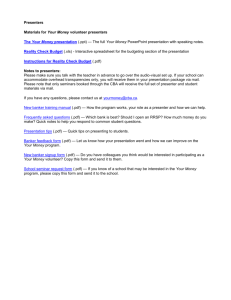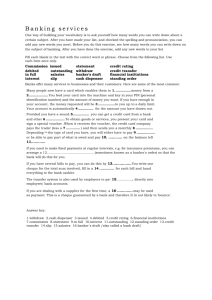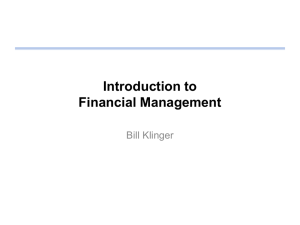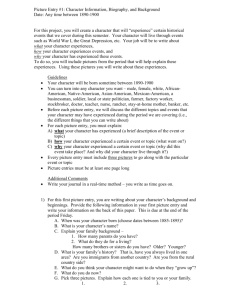ACCOUNTANT_STANDARDS - rajeshindukuristudyplace
advertisement
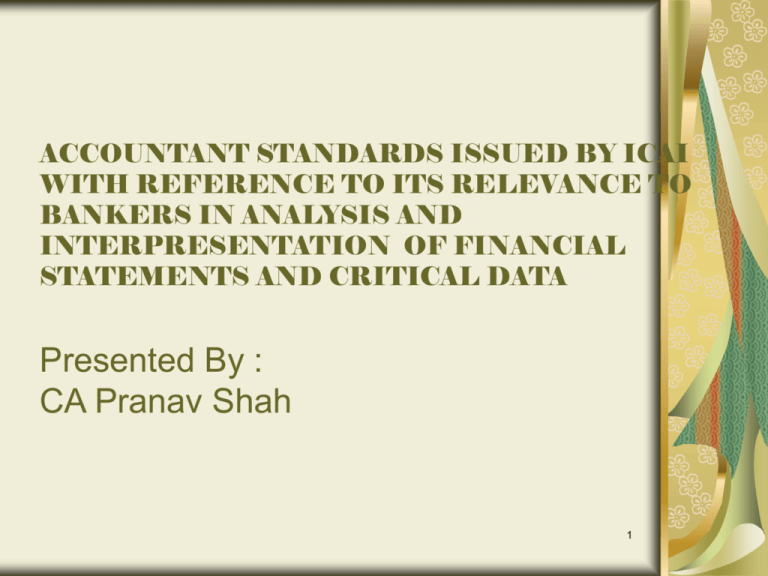
ACCOUNTANT STANDARDS ISSUED BY ICAI WITH REFERENCE TO ITS RELEVANCE TO BANKERS IN ANALYSIS AND INTERPRESENTATION OF FINANCIAL STATEMENTS AND CRITICAL DATA Presented By : CA Pranav Shah 1 Meaning of Accounting Standards Accounting Standards relate to the codification of generally accepted accounting principles. These are the norms of accounting policies and practices by way of codes or guidelines to direct as to how the items which go to make up the financial statements should be dealt with in accounts and presented in the annual accounts. The main purpose of standards is to provide information to the users as to the basis on which the accounts have been prepared. Disclosure of accounting policies enables the users to interpret the reported information. Standards may consist of detailed rules to be adopted for accounting treatment of various items before the presentation of financial statements. 2 List of Accounting Standards : Disclosure of Accounting Policies AS-1 Valuation of Inventories AS-2 Cash flow Statement AS-3 Contingencies & events occurred after the Balance Sheet Date AS-4 Depreciation Accounting AS-6 Revenue Recognition AS-9 Fixed Assets AS-10 3 Accounting for the effects of changes in Foreign Exchange Rates AS-11 Accounting for Investments AS-13 Related Parties Disclosure AS-18 Earning per Share AS-20 Accounting for taxes of Income AS-22 Provisions Contingent Liabilities & Contingent Assets. AS-29 4 AS-1: Disclosure of Accounting Policies Significant Accounting Policies followed in preparation of accounts be disclosed at one place along with the financial statements. Any change & financial impact of such change of Accounting Policies should be disclosed. If Fundamental Assumptions (going Concern, consistency & accrual ) are not followed , the fact must be disclosed. Accounting policies adopted by the enterprise should represent true & Fair view of the state of affairs of the financial statements. 5 Reference of Annual Report of Micro inks Ltd.for financial year Dec.2006 Financial Statement have been prepared under Historical cost convention on an accrual basis & in accordance with the generally accepted accounting policies issued by ICAI referring to in Sec 211 (3C) of the companies Act ,1956. 6 BANKER’S CONCERN :AS -1 The impact of any change in Accounting Policies shall effect on the profitability of the company. It should be construed with reference to the existing policies & new policies adopted by the company & how far it is justified & acceptable to bank. For e.g. Change in valuation method from Weighted Average to FIFO may have impact on the profitability. 7 AS-2 : Valuation of Inventories Valued at the lower of cost & Net realisable value. It is Sum of the Cost of purchase, cost of conversion & other cost. This AS is not applicable to Construction Contract, Service providers ,Financial Instruments & Livestock Determination of costa) Specific Identification method for determining cost of inventories means directly linking the cost with specific item of inventories. b) Specific Identification method for determining cost of inventories when not applicable then use FIFO and Weighted average method. 8 Reference of Annual Report of Micro inks Ltd. for financial yearDec.2006 The finished & semi finished inventories are valued at lower of cost on absorption basis & Net realisable value. Raw material & packing material are valued at lower of cost & Net realisable value. However ,materials & other items held for use in production of finished goods are not written down below cost if the product in which they will be incorporated are expected to be sold at or above cost. Cost is determined on a transactional weighted average basis, net of CENVET benefits availed by the companies. 9 Damaged , unserviceable & inert stocks are depreciated. Excise duty & custom duty payable on goods held in the bonded warehouse are provided in valuation of inventories . Consumables & other spares, tools , etc. are valued at lower of cost( transactional weighted average cost ,net of CENVAT benefits availed by the companies) & net realisable value. 10 BANKER’S CONCERN : AS-2 Non compliance of AS-2 relating to valuation of inventories would result in the true & unfair view of the state of affairs of the company & it would ultimately has an impact on profitability and all the accounting ratios which affects assessment of the proposal of the banker. 11 AS-3 Cash Flow Statement Tool of assessing the liquidity & solvency position of the enterprise. Applicable to enterprise those turnover is more than Rs. 50 crores. These are divided in 3 heads : From operating activities From investing activities From financing activities Cash flow includes - Cash + Cash equivalent i.e. short term liquid investment having maturity less than 3 months 12 BANKER’S CONCERN : AS - 3 By studying the cashflow Statement the banker would be in a position to make out as to whether the profit/cash accruals earned by the company is from operating activities , investing activities & financial activities which would assist in appraisal of future cashflows of the company. 13 AS-4 : Contingencies & events occurring after the date of Balance Sheet date Contingencies means result not known on B/s date & depends on happening & non happening of the events in future. Contingencies loss should be provided for by a charge in the statement of P/L ,if probable future event confirm it. Contingencies gain should not be recognised in the financial statement. Events after B/S date means which occur between B/S date & date of which financial Statement are approved by competent authority. They are significant & may be favorable & unfavorable. Accounting Treatment for events after B/S date loss should be accounted in the accounts & Assets – Liabilities are adjusted .OR Disclosure by way of Notes to accounts only . 14 BANKER’S CONCERN : AS- 4 Any contingency / event which happens after the Balance Sheet date for e.g. Breaking out of a fire in the company’s factory which an inadequate insurance would cause a huge loss to the company which will be reflected in the Books of Accounts of next financial year but it can be assessed by the bankers referring to Notes of Accounts wherein the compliance of AS 4 is disclosed. 15 AS-6 : Depreciation Accounting Measure of value of a depreciable asset arising from use, passage of time. Applicable to assets used for period more than one year. Calculated by 2 methods – Straight line method (SLM ) & Written Down Balance Method (WDBM) In case of extension, revaluation or exchange fluctuation ,deprecation is provided on adjusted figure . 16 Reference of Annual Report of Micro inks Ltd. for financial year Dec.2006 Depreciation is provided on SLM basis on all assets at the rate prescribed in Schedule XIV of the companies Act,1956 Depreciation on the assets not owned by the company’s included in Gross Block is provided over the estimated period of the economic life of the assets. Depreciation is charged on pro rata basis for the assets purchased/Sold during the year. 17 BANKER’S CONCERN : AS - 6 Change in method of depreciation should be based on some sound acceptable reasoning & its effect must be incorporated with retrospective effect i.e. the date on which assets is put to use. 18 AS-9 : Revenue Recognition It explains when revenue is recognized in P/L account & when postponed. Revenue is gross inflow of cash,receivable or other consideration arising in course of ordinary activities of an enterprise. In case of sale of goods revenue is recognised when 3 conditions are fulfilled as Goods transfer from seller to buyer for a price Seller does not retain any effective control on transferred goods. No uncertainty in collection of the amount of consideration. In case of rendering of Services 2 methods are applicable Completed Service Contract Method 19 Proportionate completion Method Reference of Annual Report of Micro inks Ltd. for financial year Dec.2006 Domestic sales are recognised at time of despatch to the customer, on the basis of invoice. Export sales are recognised on the basis of dates of bills of lading. Gross sales include excise duty but exclude custom duty ,education cess, sales tax, other recoveries set off against the respective expenditure heads & are net of trade discount. 20 BANKER’S CONCERN : AS- 9 Revenue recognition is particularly important when goods are transferred through sales invoice to a Sister concern where generally the company is not having business terms with that Sister Concern . Only to book the profit the goods have shown to be sold & then returned back after 1st April in the new financial year .You may also refer to AS 18 which will be discussed later on. 21 AS-10 : Accounting For Fixed Assets Cost comprise of its Purchase price & any attributable to the asset to its working conditions. Self-Construction assets shall be accounted at cost. Assets on Hire basis should be recorded at fair value. Gross & net values at the beginning & end of year showing additions, deletions and other improvements is required to be disclosed. 22 Reference of Annual Report of Micro inks Ltd. For Dec.2006 Fixed Assets are stated at historical cost of acquisition or construction less accumulated depreciation/ amortisation. All cost relating to acquisition & installation of fixed assets are capitalised.The cost excludes the duty benefits admissible against installation of the specific assets. . 23 In respect of loan’s & suppliers credit arrangement for purchase assets repayable in foreign currencies, the net increase in the Company’s liability for repayment consequent upon realignment in rupee value is capitalised Advances payment for acquisition/construction & cost of assets which are not put to use as at reporting date are disclosed under capital WIP 24 BANKER’S CONCERN : AS -10 Whether the Fixed Assets have been purchased from long term funds or short term funds have been used to finance the purchase of Fixed Assets as it would badly affect the working capital cycle of the company further the interest paid for acquisition of Fixed Assets prior to commercial production should be capitalised. 25 AS-11 :Effects of changes in Foreign Exchange rates Applicable to all enterprises for which accounting period commence on or after 1/04/04. Monetary items denominated in foreign currency shall be reported at closing rated. Non monetary items carried in terms of historical cost in foreign currency reported at exchange rate on the date of the transaction. All types of exchange differences will be charged to P/L for the period. 26 Reference of Annual Report of Micro inks Ltd. for financial year Dec.2006 Transactions in foreign currency recorded at the rates of exchange in force at the time of occurrence of the transactions. Outstanding recoverable & payable in foreign currency at the reporting date are stated at the rates of exchange prevailing at the reporting date or at the forward rates relevant to the transaction. Gains / losses on cancellation of Forward Exchange Contracts are recognised in the P/L Account 27 BANKER’S CONCERN : AS - 11 Any non compliance of AS-11would result in higher profitability & consequently the ratios calculated would also not give a correct picture of the companies financial performance. 28 AS-13 : Accounting for Investment It is assets held for earning income by way of dividend , interest & rentals, for capital appreciation or for other benefits. Cost of Investment include acquisition charges , e.g. brokerage , fees and duties. Investment readily realisable & held not more than a year are classified as current assets Current investment disclosed at lower of cost & fair value. Long term investment disclosed at cost. 29 Reference of Annual Report of Micro inks Ltd. for financial year Dec.2006 Long term investments are stated at the cost, less provision , if any , for diminution in value other than temporary Current Investments are stated at cost & fair value whichever is lower. 30 BANKER’S CONCERN : AS - 13 If no provision is made for diminution on the value of investment then to that extant profit of the company would be shown on higher side therefore while apprising the proposal the profitability of the company may be recalculated. 31 AS-18 : Related Party Disclosures Parties are considered to be related if, any time during reporting period, one party has ability to control or exercise significant influence over the other party in making financial and /or operating decisions. Name of the related party & nature of related party relationship must be disclosed even there is no transactions but control exist. 32 BANKER’S CONCERN : AS - 18 In case of AS 18 bankers would be able to know whether the disclosure to the bank regarding group concerns / Sister concerns have been truly made or not & whether to include or exclude such group concerns book debt while calculating drawing power. 33 AS-20 : Earning Per Share It is financial ratio that gives the information regarding earning available to each equity share. It shows market price of a share. Applicable to enterprise whose shares are listed in Stock exchange. These are of 2 types – basic EPS & Diluted EPS They must be shown in the profit & loss statement even if negative. Basic EPS calculated by dividing net P/L for the period attributable to equity shareholders by weighted average of equity shares outstanding during the year . Diluted EPS calculated as net P/L for the period attributable to equity shareholders by weighted average of shares are adjusted for the effects of dilutive potential equity share . 34 AS-22 : Accounting for taxes on income There are two types of tax Current tax & the deferred Tax. Current tax measured at the amount expected to be paid to ( recovered from ) the taxation authorities , using the applicable tax rates & tax laws. Deferred tax assets & liabilities should be measured using the applicable tax rates & tax laws that have been enacted by the Balance Sheet date. 35 Both the current & Deferred tax, assets & liabilities are shown distinguish from each other. Nature of evidence supporting the recognition of Deferred tax assets should be disclosed, if an enterprise has unabsorbed depreciation or carry forward of losses under tax laws. 36 Reference of Annual Report of Micro inks Ltd. for financial year Dec.2006 Provision for current tax based on taxable profit for the 9 months period upto Dec 31,2006. The actual liability will be determined on the basis of the results for the period April 1 ,2006 to March 31, 2007.in accordance with Income Tax Act ,1961 Provision for Fringe Benefit Tax is made in accordance with provisions of Income Tax Act ,1961 Deferred tax is recognised , on timing difference , being the difference between taxable income & accounting income that originate in one period and are capable of reversal in one or more subsequent periods. 37 Deferred tax Assets in respect of unabsorbed & carrying forward losses are recognised if there is virtual certainty that there will be sufficient future taxable income available to realise such losses. 38 BANKER’S CONCERN : AS -22 The deferred tax liability which is a liability entry passed by way of notional entry to bring the Indian Accounting Standard in harmony with International Accounting Standard & to eliminate the time difference between Income Tax Act & Companies Act. 39 AS-29 : Provisions ,Contingent liabilities & contingent Assets Provision is a liability , which can be measured by using a substantial degree of estimation. Contingent liabilities is a possible obligation that arises from past event & existence of which will be confirmed only by the occurrence or non occurrence of one or more uncertain future events. Contingent liabilities are not recognised in the P/L account & disclosed in notes to the accounts. 40 Reference of Annual Report of Micro inks Ltd. for financial year Dec.2006 A provision is recognised when the company has a present legal or constructive obligation as a result of past event & it is probable that a outflow of resources will be required to settle the obligation. Provisions ( excluding retirement benefits ) are not discounted to its present value & are determined based on best estimate require to settle the obligation at the Balance Sheet date 41 BANKER’S CONCERN : AS -29 Whether all the provisions have been made in books of accounts & whether they have been correctly recorded. The impact of contingent liability on the future cashflows of the company. 42 THANKS YOU 43

